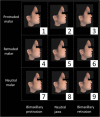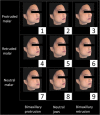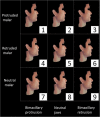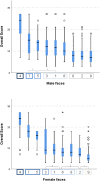Evaluation of the relationship between malar projection and lower facial convexity in terms of perceived attractiveness in 3-dimensional reconstructed images
- PMID: 32345357
- PMCID: PMC7187519
- DOI: 10.1186/s13005-020-00223-5
Evaluation of the relationship between malar projection and lower facial convexity in terms of perceived attractiveness in 3-dimensional reconstructed images
Abstract
Background: This study aimed to investigate dental student's perception of facial attractiveness with regard to different combinations of anteroposterior malar-jaw positions using 3-dimensional (3-D) reconstructed images of subjects.
Methods: Two Chinese young adults (1 male and 1 female) with straight profiles and average malar projections were selected for the study. 3-D facial images and cone-beam computed tomography images of these two subjects were superimposed using 3-D imaging software. Lateral and oblique views of nine different images were created by moving the maxillomandibular complex and/or zygomatic bone by 4 mm either forward or backward along the sagittal plane. One hundred three undergraduate dental students (n = 24, 33, and 46 students from the Year 3, 4, and 5, respectively) then scored lateral and 45° oblique view images of the newly reconstructed faces.
Results: In the present study, images with a neutral malar and retruded jaws were found to be the most attractive in both male and female subjects. In addition, the Protruded malar (PM) group (p < 0.001), and the Retruded Jaws (RJ) group were rated more attractive (p < 0.001). Furthermore, the Relatively Prominent malar (RP) group was rated more attractive (p < 0.001) when malar-jaw relative positions were compared.
Conclusion: This study shows that a neutral or a protruded malar favours facial attractiveness in both Chinese male and female subjects. Therefore, an appropriate relationship between malar projection and lower facial convexity should be taken into consideration while designing the orthodontic/orthognathic treatment plans for enhanced aesthetic outcomes.
Keywords: 3-dimensional; CBCT; Jaws; Lower facial convexity; Malar.
Conflict of interest statement
The authors declare that they have no competing interests.
Figures







References
-
- Langlois JH, Kalakanis L, Rubenstein AJ, Larson A, Hallam M, Smoot M. Maxims or myths of beauty? A meta-analytic and theoretical review. Psychol Bull. 2000;126(3):390–423. - PubMed
-
- Pabari S, Moles DR, Cunningham SJ. Assessment of motivation and psychological characteristics of adult orthodontic patients. Am J Orthod Dentofac Orthop. 2011;140(6):e263–e272. - PubMed
-
- Patcas R, Cunningham SJ, Shute J, Lloyd T, Obwegeser JA, Arjomand L, et al. Motivation for orthognathic treatment and anticipated satisfaction levels-a two-Centre cross-national audit. J Craniomaxillofac Surg. 2017;45(6):1004–1009. - PubMed
-
- Terino EO. Alloplastic facial contouring: surgery of the fourth plane. Aesthet Plast Surg. 1992;16(3):195–212. - PubMed
MeSH terms
LinkOut - more resources
Full Text Sources

